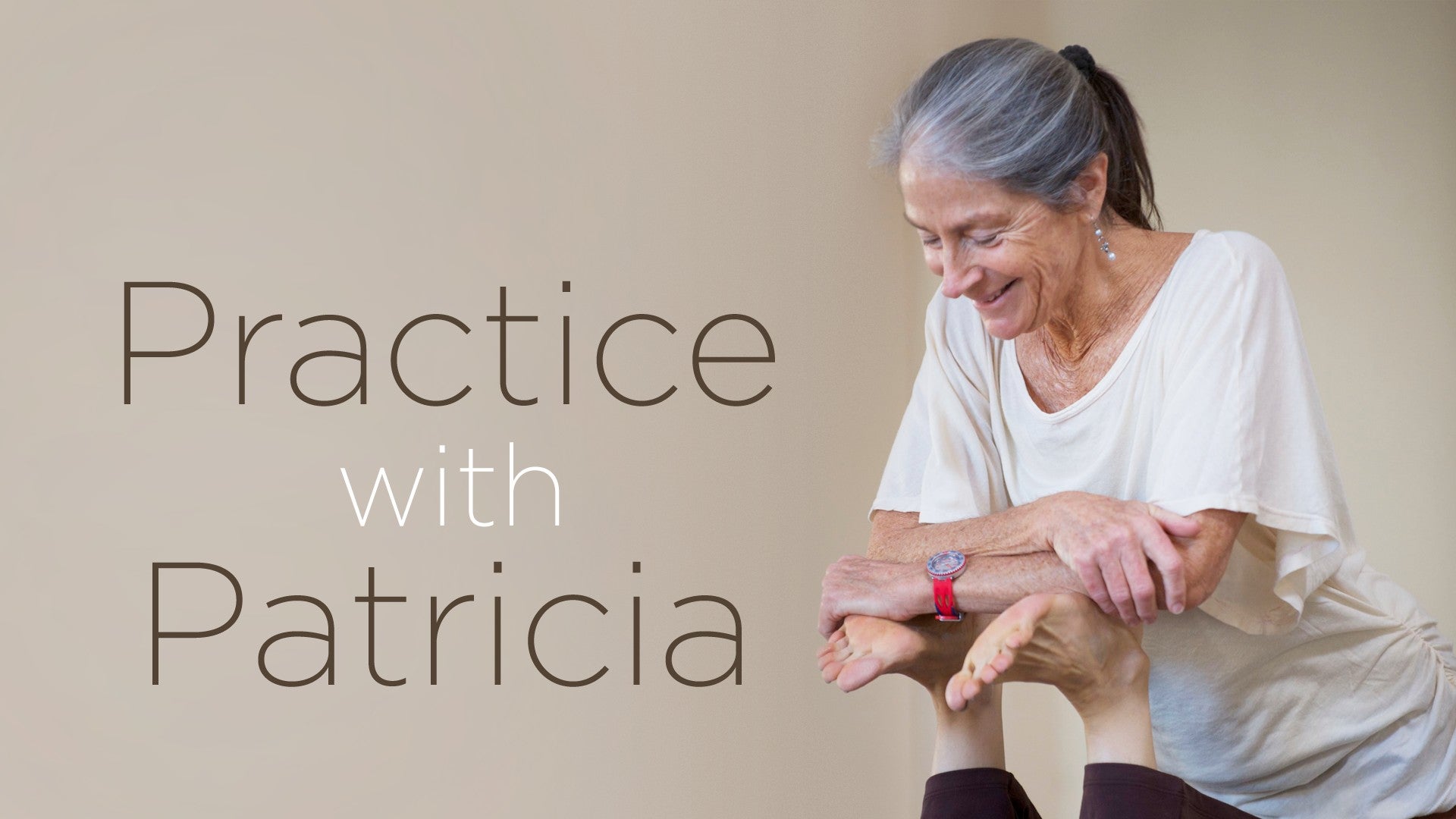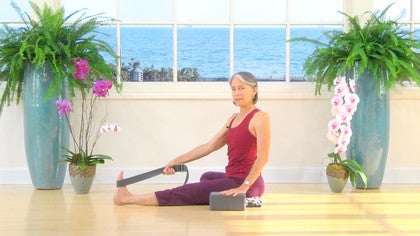Description
About This Video
Transcript
Read Full Transcript
Today we're going to do a couple of breaths that lead into a nice state of mind for sitting and then we'll sit for a few minutes. And you'll want something to sit on, so I happen to have a sandbag and a blanket today. Sometimes I just sit on a couple of blankets. And if I were going to be here longer than we're going to be here today, I would actually put something under my knees. Right now my feet are supporting my knees, but that would put my feet to sleep after about 10 or 15 minutes. So for the longer sits, support is really great.
The first breath is a hissing breath, and it's done with the lips partly open and the teeth partly closed. And you'll be doing this lying down, but I want to explain it first, so you'll be... hissing the breath out. And then we'll repeat that several times. And then we'll get up and we'll do Brahmari Breath, which is a wonderful vibratory bee-like sound inside the skull, which really helps calm the sometimes big waves in the brain so we get the grounding with the hissing breath and then we get the calming and soothing for the upper areas. So lying down, knees bent. If you like you can let the knees fall together. Hands to the belly. Just take a couple of breaths to begin with. Just nice and easy. Noticing where the breath touches the inside of you. Noticing your state of mind. And now after a good deep inhalation you're going to start the hissing and your belly will be going down down down towards your back while you're hissing and breathing out and then you let go of all the muscles that have made that happen and you breathe in and you'll feel the belly rise. We'll do this three or four times. So in breath and then begin. Let go of the muscles that push the breath out.
Just let a spontaneous breath come in, hiss out again. One more. And then just feel. Your eyes can be closed. Just feel. People sometimes report to me that their sinuses feel cooler and clearer and I can feel that now. The brow relaxes and the belly is now nicely centered in my belly. Belly breath. Belly breath centered. And I also feel easier breath in my chest. Giving yourself time to notice what's actually happening right now for you. Then we're going to roll over to the side and come up. I can tell it's working because my voice has gotten calmer. It's amazing. Three or four breaths. It's like magic. I use this a lot. Driving just before teaching. Okay so back up to your sitting cushion. The Brahmari breath. So this is a B sound so your voice will be rather low and you want to imagine a B and the B is finding the appropriate place in your head to you know to to pollinate and to allow this beautiful feeling to grow to flower inside you. So we'll do three of these. One just with the hands down. Two I'm going to suggest you use your fingers or your thumbs. I like to use my fingers to plug the ears. It increases the sound so that you you hear more of the nuance of what's happening in there. And if you find that quite lovely you can do the third breath like that too. Otherwise hands can come back down. I just want to let you know also that according to what you're doing with your tongue the sound is not only different sounding but you can feel different places in your head receiving the vibration and you find one that's interesting for you. So you begin with the tongue not pressing any part of the vault of your mouth and then you can play with maybe putting it behind your front teeth or back towards the soft part of you of the roof of your mouth and just notice what happens. And then when we go into meditation I could do this now actually. I like to have something across my lap because I tend not to have my hands on my knees. I tend to often to have my hands here in my lap and this gives me a little support for that and if it's cold that helps too. Okay so we'll begin the brahmari breath and then I'll give you a little bit of guided meditation and then some silence. So deep breath. Use the fingers this time. And then the third one.
Feel the breath come into your belly. Notice what you notice elsewhere. If anything you feel anything in this in the head range in. Eyes for this meditation can be open or closed. Just being with your breath your upright posture had really centered over the central organizing axis of your body or spine. Feel yourself on the ground and feel the ground supporting you and your breath. This innate presence that can be felt in the belly. If there's any tightness or heaviness or activity anywhere else in the body just melt it down and let it come down into your belly and feel your breath moving in your belly. You'll feel other things but focus on that for two or three more breaths. And then keeping a sense of tether and anchoring in your belly. Let your breath come up towards your heart this time as you breathe in. Feel the easy openness. Keep the back of your neck long and your eyes though open or closed. There's a kind of a focus that settles into your heart. And you're going to be allowing thoughts to arise without grasping onto them which is our typical way. And as you do this feeling the breath sometimes in the belly sometimes in the heart always coming back to the breath. A thought may put you on its train. If you find that your thoughts get on a train and get carried away by it you can instantly after you've noticed get off the train and you'll be right back here. It's not like throwing yourself off a movie train. You just come right back and every time that happens you've woken up once again. So waking up to the present moment. It's a kind of a combination between letting go and concentrating.
Both are happening. So we'll sit for a few minutes now and after just a few minutes then we'll close and we'll close perhaps with a chant and bow out. Again eyes open or closed. Welcoming the present moment as it comes to you. Releasing it as it very quickly goes away. Releasing it as it very quickly goes away. Releasing it as it very quickly goes away. Releasing it as it very quickly goes away.
Releasing it as it very quickly goes away. Releasing it as it very quickly goes away. If your eyes are closed let them open just a soft focus. Give yourself a few moments to taste the rasa, which means flavor. Taste the flavor of your practice right now. Even if the mind has been moving a lot, even if you felt restless and so on, sometimes the aftertaste is sweet anyway. Just notice. And then we will just bow out. So palms together with a little bit of space here for carrying a seed. And with this seed here at your heart, just bowing to yourself, bowing to all, namaste.
Practice with Patricia
Comments
Share it! Love, P
You need to be a subscriber to post a comment.
Please Log In or Create an Account to start your free trial.
















